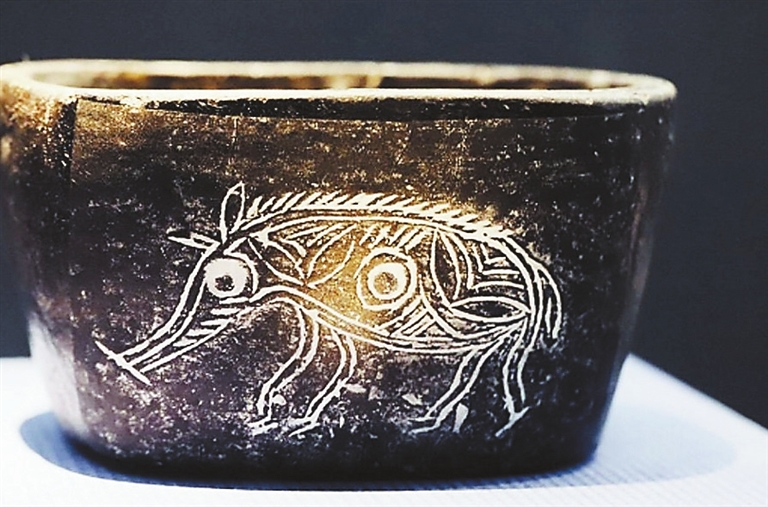
THE recent Lunar New Year marks the start of the Year of the Pig. The pig, which appears as the last of the 12 Chinese zodiac creatures, has undoubtedly struck an emphatic cultural note. The reason, says Shi Chao of Zhejiang Provincial Museum in Hangzhou, is simple. “We Chinese value family above almost everything else. And, of all the zodiac animals, the pig is the one most closely associated with the Chinese notion of a family,” he says, pointing to a piece of oracle bone dating to China’s Shang Dynasty (16th century-11th century B.C.). The symbol on the ox scapula is the antecedent of the contemporary Chinese “家”, meaning family. “The oracle bones are hieroglyphic,” Shi says. “The top of the word resembles a roof, and the part underneath it is believed to be the simplified rendering of a boar or its domesticated descendant, the pig.” In fact, that part eventually evolved into a separate character, “豕”, meaning pig. So it seems that, to ancient Chinese, no family could be rightfully called a family without pigs. “Pigs became an important gauge for families’ wealth during the Han Dynasty (206 B.C.-A.D. 220),” Shi says. “At the time, to marry into wealth would, in effect, mean marrying into a family with a big pig farm.” Among the funerary objects unearthed from Han tombs are miniature pottery yards complete with henhouses and pigsties. However, although pigs are said to have been as important to the Chinese as cows were to Europeans and goats to Arabs, many boar-like images unearthed along the historic transcontinental trade route known today as the Silk Road are believed to have come from the West. The intricately woven Persian brocades traded on the ancient Silk Road often featured medallion patterns centered with the head of a boar. People of the Sassanian Empire, which was the last kingdom of the Persian Empire before the rise of Islam, were very militarily-oriented and therefore worshipped the wild boar, an animal known for its bellicosity. Another example of cultural exchanges that concerns the image of pigs and boars involves the mural paintings at the Dunhuang Grottoes in Gansu Province. With murals dating back to between the fourth and 10th centuries, the grottoes are treasure troves of Buddhist art. In Cave 249, a mother pig and her piglet can be discerned amid swirls of color. With Buddhism, many Indian deities also made their way eastward to China, where they underwent localization. Among them was Marici, a goddess associated with light and the sun. Marici was usually depicted as either perched on the back of a boar or riding a fiery chariot pulled by seven savage boars or sows. One gold hair piece unearthed from the burial ground of a Ming Dynasty (1368-1644) prince in Central China’s Hubei features the multi-armed goddess, sitting on a sow-drawn chariot. Set with rubies and sapphires, the glistening headpiece was meant for an aristocratic woman, who may have prayed for her husband’s lasting favor. This tenuous link between Buddhism and the pig was further explored by the Ming novelist Wu Cheng’en, who wrote “Xiyouji,” or “Journey to the West.” It was inspired by the true story of Xuanzang, a monk living in the seventh-century China, who traveled 25,000 kilometers before arriving in India and later returned with loads of Buddhist scriptures. The entire journey took 17 years. In Wu’s rendition, the monk was still there, but the journey was made even more treacherous by the many demons that populated the pages and craved his flesh. Fear not: the determined man had three disciples who protected him — the resourceful Wukong, aka the Monkey King, the faithful Wujing and the pig-faced, barrel-bellied Wuneng, who had been banished from heaven for flirting with a fairy. In the novel, the pig-man was portrayed almost as an antithesis to everything considered devout or virtuous. A lecherous gourmand who tended to waver in times of difficulty, he nevertheless managed to complete the journey and was re-sanctified by the Buddha. This hilarious image was canonized in Chinese literature thanks to the tremendous success of the book, both at the time of its publication and later. “When the book was introduced to the West, the pig-man became an instant hit,” Shi says. “Of all the main characters of the book, he is the most down to earth. The fact that he had to make a constant effort to resist temptation sounds familiar to every one of us.” People have always sought wealth and power, things the ancient Chinese believed the pig could help humans obtain. Zhu, the Chinese pinyin for pig, is pronounced the same as red. And when ancient Chinese took the palace examination, in which good performance would often mean entry into the country’s bureaucracy, their papers were marked by the emperor wielding a brush dipped in red. Consequently, it was common for everyone who wanted to trot up the ladder of promotion to eat pigs’ feet. Times change, but pigs’ feet braised in soy sauce never lost its charm or its position in Chinese cuisine. (China Daily) | 
